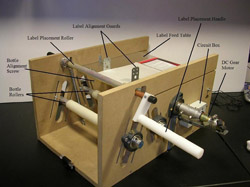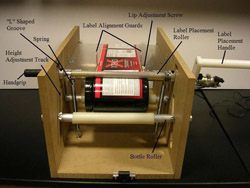Client Coordinators: Joe Bumgarner, John Wiltshire
Designers: Matthew Dekow, Gregory Meyers, Cameron Smith
Supervising Professor: Larry Bohs
 INTRODUCTION
INTRODUCTION
The Cylindrical Bottle Label Applicator allows individuals with fine motor and cognitive disabilities to precisely apply labels to bottles. The device includes a stand to hold the roll of labels and the bottle to be labeled. The labels are fed onto a solid surface with a sharp edge. The label backing is curled around this edge, thereby removing the leading edge of the label from the backing. As the user rotates a handle, a non-slip roller applies the label to the bottle, while a DC motor automatically collects the backing.
 SUMMARY OF IMPACT
SUMMARY OF IMPACT
Currently, only a handful of employees at OE Enterprises, Inc, a vocational rehabilitation facility, can label large bottles accurately and consistently. This device will allow many more employees to complete this task, increasing productivity and also the rate of pay for these employees. Alan Pitstick, Director of Contract Sales at OE, commented, “The use of the machine will allow more of the workforce to be involved in bottle labeling which is central to the mission of OE Enterprises.”
TECHNICAL DESCRIPTION
Our design, shown in Figures 1 & 2, includes a label holder, backing removal mechanism, label placement apparatus, and label alignment guards. The label holder includes a tailpipe expander, two flange bearings, a friction clutch, a socket, and an aluminum rod. The tailpipe expander allows label rolls with differing shank diameters to be held securely. The friction clutch is attached to the tailpipe expander, providing the rotational friction necessary to keep tension on the sheet of labels for the label backing removal mechanism.
The label backing removal mechanism separates the backing from the adhesive label by curling the label backing around the end of the label feed table, a sheet of ¼” thick acrylic. The label backing collector, a wooden dowel with an axial slit, resides underneath the table and collects the backing to be discarded. A DC gear motor applies a constant torque, slightly less than that required to remove labels from the backing, but sufficient to wind the backing onto the collector.
The label placement apparatus includes two silicone rubber-sheathed aluminum rods, the bottle rollers, supported by flange bearings mounted to angled height-adjustment tracks routed in the sideboards. This arrangement allows the height and separation of the bottle rollers to be easily adjusted to accommodate bottles of different sizes. A label placement roller secures the bottle from the top and firmly rolls the label onto the bottle. Two extension springs add downward tension to the roller, allowing the user to simultaneously rotate the bottle and apply the label by turning a handle.
The bottle and the label are held in alignment with the label alignment guards and two bottle alignment screws. The label alignment guards are 1” L-brackets that face the center of the label feed table. The bottle alignment screws prevent the bottle from sliding along the axis of the bottle rollers, and can be moved to various set positions corresponding to different bottle sizes. Once appropriately set for a particular bottle size, these components make it simple for the user to align the bottle and label, and then to gently press the edge of the label onto the bottle to initiate contact between the adhesive side of the label and the bottle. The user then slides a finger down the edge of the label and rotates the bottle using the handle on the label placement roller, causing the remainder of the label to adhere to the surface of the bottle. The roller pushes down on the bottle, removing any bubbles that have formed at the label-bottle interface. As this process occurs, the label backing collector automatically collects the excess label backing. Cost of parts for the device was $325.